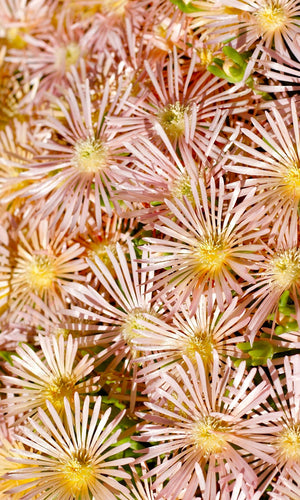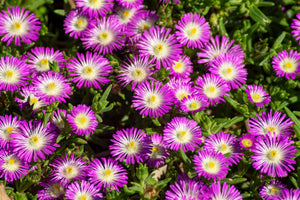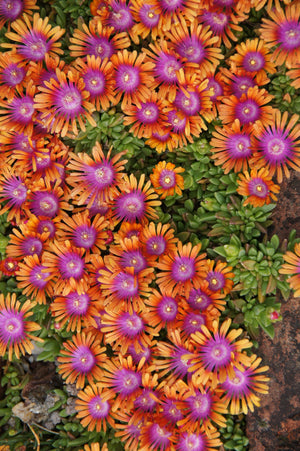The Delosperma Guide
Delosperma, commonly known as ice plant, brings a touch of vibrant color and unique texture to any garden landscape. Known for their dazzling, daisy-like blooms and succulent foliage, Delosperma plants are perfect for adding texture, color, and resilience to borders, rock gardens, and containers. These plants are admired for their ability to thrive in dry, sunny conditions and their relatively easy care. Whether you're aiming to enhance your garden's visual appeal, create a lively display, or add a unique element to your space, Delosperma offers a captivating and versatile solution. Explore our Delosperma Guide to learn more about cultivating and caring for these delightful plants, and discover how to incorporate them into your garden for lasting beauty and enjoyment.

About Delosperma
Delosperma is a genus of flowering plants in the Aizoaceae family, comprising about 150 species. These plants are native to southern and eastern Africa, particularly South Africa. The name "Delosperma" is derived from the Greek words "delos" (visible) and "sperma" (seed), referring to the exposed seeds of the plant's fruit capsule.
Delosperma plants are known for their succulent, fleshy leaves and bright, daisy-like flowers that come in shades of pink, purple, yellow, orange, red, and white. The flowers are typically small but numerous, creating a carpet of color when in full bloom. The foliage is usually green, although some varieties may have a bluish or reddish tint. Delosperma plants are low-growing, spreading perennials that form dense mats, making them ideal for ground cover.
Some popular species and varieties of Delosperma include Delosperma cooperi (Trailing Ice Plant), known for its magenta flowers and vigorous growth, Delosperma nubigenum (Yellow Ice Plant), with its bright yellow flowers and compact habit, and Delosperma 'Jewel of Desert' series, which features a range of vibrant colors and exceptional cold tolerance. Each species and variety has its unique characteristics, but all share the common traits of colorful flowers and easy care.

Planting Delosperma
Delosperma plants require specific planting conditions to ensure their successful establishment and flourishing growth. Here are some essential guidelines for planting and caring for Delosperma:
Soil: Delosperma prefers well-draining soil that is sandy or gravelly. Poor to moderately fertile soil works best. Ensure the planting site is free from heavy clay or waterlogged conditions, which can cause root rot. Adding coarse sand or grit to the soil can improve drainage.
Light: Delosperma thrives in full sun. Choose a location with at least six hours of direct sunlight per day for optimal blooming. In shadier locations, the plants may become leggy and produce fewer flowers.
Watering: Delosperma is drought-tolerant once established but requires regular watering during the initial growth period. Water the plants deeply, allowing the soil to dry out completely between waterings. Overwatering can lead to root rot, so it's important to err on the side of under-watering.
Planting Depth: Plant Delosperma at the same depth as it was growing in its pot or nursery container. Space the plants 12-18 inches apart to allow for proper air circulation and growth. When planting in the ground, dig a hole twice as wide and the same depth as the root ball to encourage root spread.
Mulching: Apply a layer of gravel or coarse sand around the base of the plants to retain moisture, suppress weeds, and regulate soil temperature. Avoid using organic mulches, which can retain too much moisture and lead to rot.Delosperma plants require specific planting conditions to ensure their successful establishment and flourishing growth. Here are some essential guidelines for planting and caring for Delosperma:
Soil: Delosperma prefers well-draining soil that is sandy or gravelly. Poor to moderately fertile soil works best. Ensure the planting site is free from heavy clay or waterlogged conditions, which can cause root rot. Adding coarse sand or grit to the soil can improve drainage.
Light: Delosperma thrives in full sun. Choose a location with at least six hours of direct sunlight per day for optimal blooming. In shadier locations, the plants may become leggy and produce fewer flowers.
Watering: Delosperma is drought-tolerant once established but requires regular watering during the initial growth period. Water the plants deeply, allowing the soil to dry out completely between waterings. Overwatering can lead to root rot, so it's important to err on the side of under-watering.
Planting Depth: Plant Delosperma at the same depth as it was growing in its pot or nursery container. Space the plants 12-18 inches apart to allow for proper air circulation and growth. When planting in the ground, dig a hole twice as wide and the same depth as the root ball to encourage root spread.
Mulching: Apply a layer of gravel or coarse sand around the base of the plants to retain moisture, suppress weeds, and regulate soil temperature. Avoid using organic mulches, which can retain too much moisture and lead to rot.

Care for Delosperma
Delosperma plants require specific care to ensure their optimal growth and health. Here are some general guidelines for the care of Delosperma:
Watering: Keep the soil consistently dry during the growing season. Water the plants deeply, allowing the soil to dry out completely between waterings. During prolonged dry periods, increase the frequency of watering slightly to maintain soil moisture. Overwatering should be avoided to prevent root rot.
Fertilizing: Delosperma does not require heavy fertilization. Apply a balanced, slow-release fertilizer sparingly in the spring as the plants begin to grow. Over-fertilizing can lead to excessive foliage growth at the expense of flowers.
Pruning: Prune Delosperma plants lightly to maintain their shape and encourage bushier growth. Remove spent flowers to promote continuous blooming and trim back any damaged or dead foliage as needed. Pruning is best done in late spring or early summer.
Pests and Diseases: Delosperma is relatively pest-resistant but can be susceptible to issues such as aphids and mealybugs. Inspect your plants regularly and treat any infestations promptly with appropriate organic or chemical controls. Maintain proper spacing and air circulation to reduce the risk of diseases.
Winter Care: In colder climates, some Delosperma species may need protection during the winter. Apply a layer of gravel or coarse sand around the base of the plants to insulate the roots. If growing in containers, bring the plants indoors or move them to a sheltered location to protect them from freezing temperatures.

How to Use Delosperma
Delosperma offers versatility and can be utilized in various ways to enhance your garden and outdoor spaces. Here are some recommendations based on their characteristics:
Rock Gardens: Delosperma’s low-growing habit and drought tolerance make them ideal for rock gardens. Plant them among rocks or gravel to create a colorful and low-maintenance landscape feature.
Ground Cover: Use Delosperma as a ground cover to fill large spaces with lush foliage and vibrant blooms. Their dense growth helps suppress weeds and retain soil moisture.
Borders and Edges: Plant Delosperma along garden borders and edges to add a splash of color and texture. Their spreading habit creates a neat and attractive edge to pathways and garden beds.
Containers: Delosperma can be grown in containers, making them a versatile choice for patios, balconies, or small gardens. Choose a shallow container with good drainage and place it in a sunny spot to enjoy the plants up close.
Mixed Plantings: Combine Delosperma with other drought-tolerant plants, such as sedums, agaves, and yuccas, to create a stunning xeriscape garden. Their bright flowers and succulent foliage will complement other plants beautifully.
Erosion Control: Plant Delosperma on slopes and banks to help stabilize the soil and prevent erosion. Their spreading roots and dense growth make them effective at holding soil in place.
Conclusion
Delosperma is a captivating and versatile addition to any garden or outdoor space. With their vibrant flowers, succulent foliage, and relatively easy care, Delosperma plants bring a touch of cheerful brightness and resilience to your environment. Their adaptability to dry, sunny conditions and ease of care make them a favorite among gardeners of all levels. By following proper planting and maintenance techniques, you can fully harness the potential of Delosperma to enhance your garden, creating a lasting impact.
Whether you seek to create stunning flower displays, add visual interest to rock gardens and borders, or enjoy their beauty in containers, Delosperma can fulfill a variety of roles in your landscape design. Place them individually to highlight their unique blooms and foliage, or combine different species and varieties for a dynamic and visually appealing display. Delosperma’s resilience and adaptability also make them ideal for ground covers and erosion control.
Beyond their ornamental value, Delosperma plants contribute to the overall beauty and charm of your garden ecosystem. With their enduring beauty, versatility, and ecological significance, Delosperma plants bring delight and natural allure to your outdoor environment, enriching your gardening experience and enhancing the overall beauty of your landscape.

